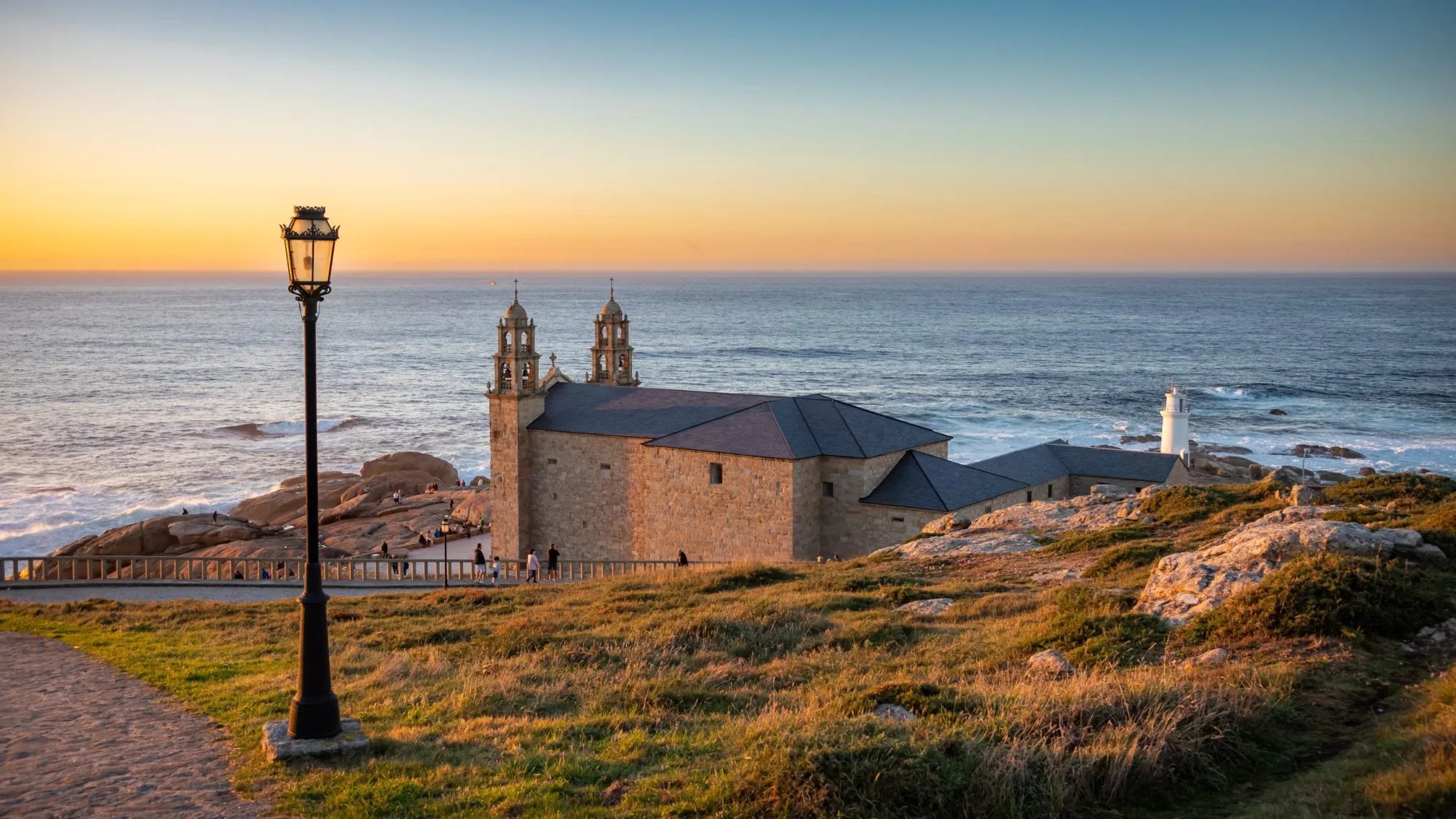Camino Finisterre: The Ultimate Guide
Discover the ultimate guide to Camino Finisterre: essential tips, historical insights, and practical advice for your spiritual journey to the end of the world.

Quick links
The Camino Finisterre, an extension of the Camino de Santiago, offers a unique experience for those seeking to explore beyond Santiago de Compostela. Stretching approximately to Finisterre or Muxía, this route is a historical path leading to what was once considered the edge of the known world.
This guide is a resource for understanding the unique aspects of this lesser-traveled path, offering information on the route's terrain, cultural background, and the serene beauty of its coastal terminus.

Camino Finisterre in numbers
- Length: Approximately 90 km (additional 28 km to Muxia)
- Starting point: Santiago de Compostela, Spain
- Finishing point: Cape Finisterre (or Muxia), Spain
- How many days does it take: 4-5 days
- Ideal for: Pilgrims who wish to extend their Camino journey with a shorter, spiritually significant route leading to the coast
History and origins
Camino Finisterre has roots that delve deep into the past, intertwining pagan beliefs with Christian traditions. The origins of the Camino Finisterre predate Christianity.
This ancient path was once trodden by pagans, who journeyed towards what they believed to be the literal "end of the world" – Finisterre. The name Finisterre, derived from the Latin 'Finis Terrae,' meaning 'end of the earth,' reflects this belief.
The route's earliest travelers ventured along the Costa da Morte, a coastline steeped in mystique and legend, towards the westernmost point of the known world.

Central to the pre-Christian significance of Finisterre was the Ara Solis, an altar dedicated to the sun. This sacred site, located at Cape Finisterre, was where ancient peoples worshipped the sun, believed to be the place where the sun 'died' each night.
The rituals performed here, many linked to fertility, highlight the deep-rooted spiritual and mythological significance the area held for early civilizations.
The ominous name 'Costa da Morte,' or 'Coast of Death,' associated with the region, has multiple interpretations. One theory suggests that it refers to the place where the sun 'died' each day.
Another view posits that it signifies the 'death of all known land' beyond this point. A third explanation points to the high mortality rate of sailors in these treacherous waters.

With the advent of Christianity and the establishment of the Camino de Santiago, the route to Finisterre became integrated into the pilgrim tradition. Medieval pilgrims, after visiting the tomb of Saint James in Santiago, often continued their journey to Finisterre, drawn by the mystique and spiritual allure of the region.
This blend of pagan and Christian elements was a hallmark of the route, illustrating the coexistence and fusion of different beliefs over time.
The Christianization of the Camino Finisterre, marked by the destruction of the Ara Solis altar by Saint James himself, according to legend, led to the construction of Christian sanctuaries in its stead.

This transformation was part of the broader effort by the church to incorporate non-Christian sites into Christian pilgrimage practices. Despite this, the Camino Finisterre was never fully recognized as an official Camino de Santiago but rather as an extension or epilogue to the primary pilgrimage.
The 20th-century revival of the Camino de Santiago brought a renewed interest in the Camino Finisterre. The creation of specific pilgrimage certificates for this route and promotional efforts by local entities have made it a popular choice for modern pilgrims, blending historical intrigue with the natural beauty of Galicia's coastline.
Highlights
Cape Finisterre
This legendary cape, with its stony cliffs and battering waves, has been a symbol of endings, death, renewal, and beginnings throughout history. Its mythical presence has been felt since the times of Neolithic man and early Celts, who followed the Milky Way westward to the sea, carrying their gods and practices. Cape Finisterre has been a spiritual site for various cultures, including the Romans and early Christians, making it a poignant stop on the Camino Finisterre.

Monte Facho
Located on the mountain of Cape Finisterre, Monte Facho is an ancient site where the Celts constructed a fort and performed rituals at the Ara Solis, the altar of the sun. It also houses the tomb of the Celtic crone-goddess Orcabella and the hermitage of San Guillerme from the 5th century A.D. This site encapsulates the blend of pagan and Christian influences that characterize the Camino Finisterre.

Lighthouse of Finisterre
Standing at the westernmost point of the Iberian Peninsula, this lighthouse is a symbol of guidance and hope. It was constructed in 1853 and has witnessed numerous marine battles and shipwrecks, contributing to the area's reputation as the Coast of Death. The lighthouse also marks a place of ancient Celtic worship and is a key historical monument on the Camino Finisterre.

Castle of San Carlos Finisterre
The Castle of San Carlos is a significant historical landmark on the Camino Finisterre. Built around 1757, this fortress was part of the defensive plan for the Corcubión estuary, strategically positioned alongside the Cardenal castle in Corcubión and the Príncipe castle in Cee. The castle’s irregular shape, adapted to the rocky terrain on which it stands, highlights the architectural ingenuity of the time. It played a crucial role during the War of Independence, where it was nearly destroyed by French forces and subsequently restored.

Sanctuary of Virxe da Barca
According to legend, the remains of a small stone boat that belonged to the Virgin Mary are found here. It is believed that the Virgin Mary came to this picturesque location to encourage St. James in his Christian teachings. The sanctuary, known as "Our Lady of the Boat," offers a profound connection to the spiritual history deeply rooted in the myths and legends of the region.

Terrain and difficulty
The landscape of the Camino Finisterre is varied and picturesque. The path traverses through serene meadows and gently rolling hills and offers vistas of the Atlantic Ocean.
It is interspersed with sections that wind through golden wheat fields and eucalyptus forests, adding to the diversity of the scenery. Traditional villages and towns dot the path, with occasional beaches providing scenic detours.
Camino Finisterre is categorized as relatively easy in terms of physical demand. It features mild ascents and descents without significant climbs or steep downhill sections. This accessibility makes the Camino Finisterre a suitable option for beginners or those seeking a less strenuous Camino experience.

The route's lower difficulty level, combined with its quieter nature compared to more attractive routes like Camino Frances, makes it an appealing choice for certain pilgrims.
In essence, the Camino Finisterre offers a blend of scenic variety and manageable physical challenge, making it an appealing option for those looking for a tranquil yet engaging walking experience.
If you’re searching for information on preparation for Camino Finisterre and access to a packing list, visit our comprehensive Camino de Santiago guide.
Infrastructure
The Camino Finisterre is equipped with a well-developed infrastructure that caters to the diverse needs of pilgrims, ensuring their journey is both comfortable and convenient.
As travelers embark on this historic path, they find a variety of accommodations readily available. These range from public and private albergues with a communal and authentic pilgrim experience to more private options like hostels, hotels, and guesthouses.

Along the route, the culinary needs of pilgrims are well catered to. Restaurants, cafes, and bars dot the landscape, serving local Galician delicacies and providing hearty meals that reflect the region's culinary heritage.
For those preferring to prepare their own meals or needing snacks for the road, small grocery stores and markets are accessible along the Camino.
If you wish to read about accommodations and food on Camino de Santiago in more detail, you can visit our comprehensive Camino de Santiago guide.

In terms of healthcare, while hospitals are not directly situated on the route, larger towns and villages offer medical services. Additionally, pharmacies are available at various points, supplying basic medical necessities and over-the-counter medications.
It's always a good practice for pilgrims to carry a basic first-aid kit to address minor health issues.
Regular bus services link Santiago de Compostela with Finisterre and Muxía, and taxis provide more direct routes for those who prefer it.

The Camino itself is marked clearly with the iconic yellow arrows and scallop shell symbols, guiding travelers along their journey with ease.
Communication and connectivity are also taken care of, with good mobile phone coverage across most terrain and Wi-Fi access in many accommodations.
The infrastructure of the Camino Finisterre seamlessly blends traditional hospitality with modern conveniences, ensuring that while the journey remains a reflective and historical experience, it is also marked by comfort and ease.
How to get to the starting point?
While the majority of pilgrims commence their trek to Finisterre upon completing their journey in Santiago de Compostela, the route remains accessible for those who wish to experience its unique allure independently.

By Air
For international travelers, the most convenient way to reach Santiago de Compostela is by air. The city is served by the Santiago de Compostela Airport (SCQ), which hosts a range of domestic and international flights. The airport is located about 12 kilometers from the city center. Upon arrival, travelers can opt for a taxi, bus, or rental car service to reach the city center. Regular bus services operate from the airport to the city, offering an economical and convenient option.
By Train
Santiago de Compostela is also accessible by train. The city's main railway station, Estación de Santiago de Compostela, offers connections to major Spanish cities such as Madrid, Barcelona, and Bilbao. The high-speed train service, Renfe, provides a comfortable and efficient travel option. From the train station, the city center is easily reachable by taxi, bus, or a short walk.
By Bus
For those traveling within Spain or from neighboring countries, buses to Santiago de Compostela are an economical choice. The city's main bus station, Estación de Autobuses de Santiago de Compostela, has regular services connecting to various Spanish cities and some international destinations. Buses are generally comfortable and offer a cost-effective means of travel.
By Car
Travelers preferring the flexibility of a road trip can reach Santiago de Compostela by car. The city is well-connected by major highways and roads, making it accessible from different parts of Spain and neighboring countries. Upon arrival, there are several parking options in and around the city center.

Local Transport
Once in Santiago de Compostela, the city's compact size makes it easy to navigate on foot. For longer distances, there are local buses and taxi services available, providing convenient transport within the city.
Regardless of the mode of transportation chosen, reaching Santiago de Compostela, the starting point of the Camino Finisterre provides easy access and a chance to explore a city rich in history and tradition before venturing on the pilgrimage to the "end of the world."
Now you know how to go, but do you also want to know when? We’ve explored the best time to visit the Camino de Santiago in more detail in our comprehensive Camino de Santiago guide.
Our Camino Finisterre tours
For those seeking a more structured and hassle-free Camino Finisterre experience, traveling with a hiking agency can be an excellent option. Agencies offer a range of services, including pre-arranged accommodations, luggage transfers, and detailed route guides.
You can explore our Camino Finisterre tours to find a package that suits your needs. Our services are designed to enhance your pilgrimage, ensuring a memorable and fulfilling journey on the Camino Finisterre.

HASSLE-FREE
We handle itineraries, accommodations, and anything else you prefer not to deal with, so you can enjoy a carefree hike.
.svg)
TRIED & TESTED ADVENTURES
Only the best of Camino de Santiago, cherry-picked by our local team with an in-depth knowledge of the region.

SELF-GUIDED TRAVEL
Explore independently and with confidence while we keep everything running from behind the scenes.
TRUSTED BY MANY
Since 2014, we have taken care of thousands of happy customers, making it our mission to put your satisfaction first.

